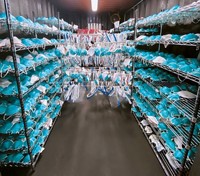Advertisement
Grab your lab coat. Let's get started
Welcome!
Welcome!
Create an account below to get 6 C&EN articles per month, receive newsletters and more - all free.
It seems this is your first time logging in online. Please enter the following information to continue.
As an ACS member you automatically get access to this site. All we need is few more details to create your reading experience.
Not you? Sign in with a different account.
Not you? Sign in with a different account.
ERROR 1
ERROR 1
ERROR 2
ERROR 2
ERROR 2
ERROR 2
ERROR 2
Password and Confirm password must match.
If you have an ACS member number, please enter it here so we can link this account to your membership. (optional)
ERROR 2
ACS values your privacy. By submitting your information, you are gaining access to C&EN and subscribing to our weekly newsletter. We use the information you provide to make your reading experience better, and we will never sell your data to third party members.
Education
Newscripts
Fluorescent Puppies, Maskbusters
by Faith Hayden
May 11, 2009
| A version of this story appeared in
Volume 87, Issue 19

For Adoption: Five adorable, unique dogs, part beagle, part nightlight. Born by a surrogate mother and laboratory-reared, these dogs may have a tint of red on their bellies and toenails. Serious inquiries only.
Residents in South Korea may soon be seeing an ad like this one posted on local telephone poles. Byeong-Chung Lee, So Gun Hong, and coworkers at Seoul National University, in South Korea, and elsewhere, claim they have successfully created the world's first TRANSGENIC DOGS. The team published their findings in the journal Genesis (DOI: 10.1002/dvg.20504).
The five dogs, all named Ruppy for "Ruby Puppy," produce a red fluorescent protein found in sea anemones, which under ultraviolet light causes the animals to glow a bright red similar to that of a laser pointer.
The Seoul team transferred 344 embryos bearing the sea anemone gene into 20 surrogate mother dogs. Seven of the 20 took to the implantation, and six puppies ultimately were born. Out of these, one died of chronic bronchopneumonia after it was accidently bitten by its mother.
Although the dogs only glow brightly under UV light, a slight red hue is detectable on their skin and claws in ambient light. During an autopsy of the deceased dog, red fluorescence was visible in all tissues, including its brain, heart, and bones.
What, you might ask, is the exact point of genetically engineering dogs that glow? The researchers believe that this proof-of-principle experiment will open the door for transgenic dog models of human illnesses, including heart disease and some cancers.
"Dogs exhibit 244 genetic diseases similar to those found in humans, making them one of the closest known models for various human hereditary diseases," the team writes. "Indeed, dogs have been considered as one of the most invaluable models in the research field of drug discovery."
Speaking of disease, it's time for a quick Newscripts public service announcement. In response to the World Heath Organization's upgrading of its Epidemic & Pandemic Threat Level from phase 3 to phase 5 (as of press time) because of the growing threat of an H1N1 virus pandemic, known more familiarly as SWINE FLU, sales of surgical masks have spiked around the U.S.

Although surgical masks seem like an inexpensive way to ward off the virus, the perception of their usefulness may be misleading. Back in 2007, the American Journal of Public Health reported on the effectiveness of surgical masks and respirators as influenza control measures (97, S32). It's important to note the distinction between the two. The paper defines respirators as "masks designed to shield the wearer from inhalational hazards" and surgical masks as "designed to protect others from contaminants generated by the wearer."
H1N1 causes a respiratory disease transmitted person-to-person through coughing or sneezing. Healthy individuals become infected when they touch something with the virus on it and then touch their nose, eyes, or mouth.
If you already have a transmissible illness, surgical masks might protect others by containing the droplets that can spread onto surfaces if you cough or sneeze, similar to covering your mouth. But a virus coming toward a mask from the outside would find about as much resistance to its forward motion as a person running through a sparse forest. For healthy people around sick people, the mask's best role perhaps is to remind them not to touch their face.
The Centers for Disease Control & Prevention won't tell you not to wear the masks but recommends other, possibly more effective, prevention methods such as frequent hand washing and maintaining a safe distance from anyone who appears sick.
Faith Hayden wrote this week's column. Please send comments and suggestions to newscripts@acs.org.





Join the conversation
Contact the reporter
Submit a Letter to the Editor for publication
Engage with us on Twitter